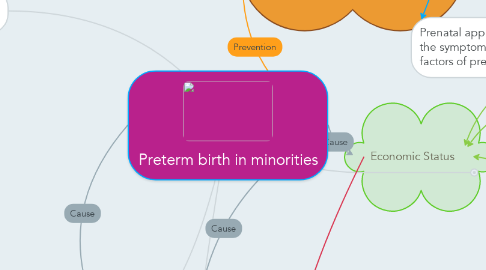Preterm birth in minorities
by Nutri Surveil

1. Personal Responsibility Education Program
2. Preterm birth prevention program
3. Blacks
4. Hispanics
5. Race & Culture
6. Environment
6.1. A teenagers environment: their neighborhood, household, school, family etc. are very important key factors in how their life develops. Teenagers that grow up in a two family home and are surrounded by love tend to have a lower risk of becoming teen parents. Inversely, teenagers who grow up around violence, substance abuse, and have one parent households tend to have higher pregnancy rates. These households many times are unstable and expose adolescents to violence and inappropriate sexual behavior. Adolescents tend to mimic whats around them. Teen mothers are more likely to have a child that becomes a teen mom themselves. Also teenagers who live in rural areas or places where the neighborhoods are in physical disorder (graffiti, abandoned vehicles, litter, alcohol container, cigarette butts, glass on the ground) have more teens who become pregnant.
7. Consequences
7.1. There are many consequences that result from teenage pregnancies. One tragic outcomes of teen pregnancy is the loss of education. Many teen mothers drop out of high school and the majority do not go to college. Teens are very impressionable so teen mothers tend to influence other teen siblings and friends around them to become teen mothers. Many teen mothers become pregnant again within two years of their first pregnancy. The children of teen mothers are more likely to end up in prison, live in poverty, and need government assistance then children that come from two family homes. Teen mothers are less likely to ever get married. Teenage mothers have higher mortality risk rates during the pregnancy for the baby and the mother. Last but not least, teen mothers are prone to mental health problems like stress, isolation, postpartum depression, and even suicide.
8. Theories that are related to prenatal care and prevention of risk factors of preterm birth (e.g. socio-ecological model)
8.1. In order to stop the cycle of teenage pregnancy and see even more of a decrease than there is now we as a society have to promote prevention. There are many different techniques that are used to try to deter teenagers from becoming parents. Education and programs that are geared towards getting the message out there on the dangers of teenage pregnancy are very helpul. Finding extracurricular activities for teenagers to do while out of school, enrolling teens in mentoring programs, and increasing programs that support and educate parents on increasing family stability help as well. Government stakeholders are the ones that usually put these programs together. From the Federal government all the way down to the local government they work together to ensure the teen pregnancy rates decrease. An example of a program that has been put together for this purpose by the government is the Personal Responsibility Education Program. This program provides $75 million annually through FY 2017 to fund evidence-based programs that emphasize both abstinence and contraception and educate adolescents on how to prevent pregnancy and sexually transmitted infections. PREP projects focus on educating adolescents from the ages of 10-19 about responsible sexual behavior and also address at least three of the following topics: healthy relationships, adolescent development, financial literacy, parent-child communication skills, education and employment preparation skills, and healthy life skills. Another government funded program is the V State Abstinence Education Program. States may use $50-75 million (About $4.5 million per State) for abstinence education, mentoring, counseling or adult supervised activities. These programs must be medically accurate and focus on youth that are at high risks of teen pregnancy, including homeless teens, those in or aging out of foster care, or who live in geographic areas with high teen birth rates. One last example of a government program aimed to help reduce teen pregnancy rates is the Teen Pregnancy Prevention Program. This program provides competitive grants to many agencies and organizations for both evidence-based programs and research and demonstration programs that develop or improve upon strategies for preventing teen pregnancy.
9. Prenatal app to identify the symptoms and risk factors of preterm birth
10. No Job
11. No money
12. Economic Status
12.1. Money is a large determinant on how many resources are available to people. The combination of being poor and living in an unequal society contributes to teens low perception of themselves as well as their chances to be economically successful. The feelings push teenagers to choices with short term satisfaction such as intercourse that, if not being done safely, can lead to pregnancy. A combination of the lack of money and the adolescent mind has many teenagers not taking the proper precautions whiles being sexually active like birth control and other contraceptions because they don't think its worth the money; not realizing a baby costs much more. Many teenagers who don't have a job don't have any money or extracurricular activities. With all this free time, many teenagers look at sexual activity as "something to do" not realizing the repercussions behind it.
13. No extracuricular activities
14. Physical/Mental Abuse in Family
15. Single Parent Homes
16. Poor Neighborhood/Community


